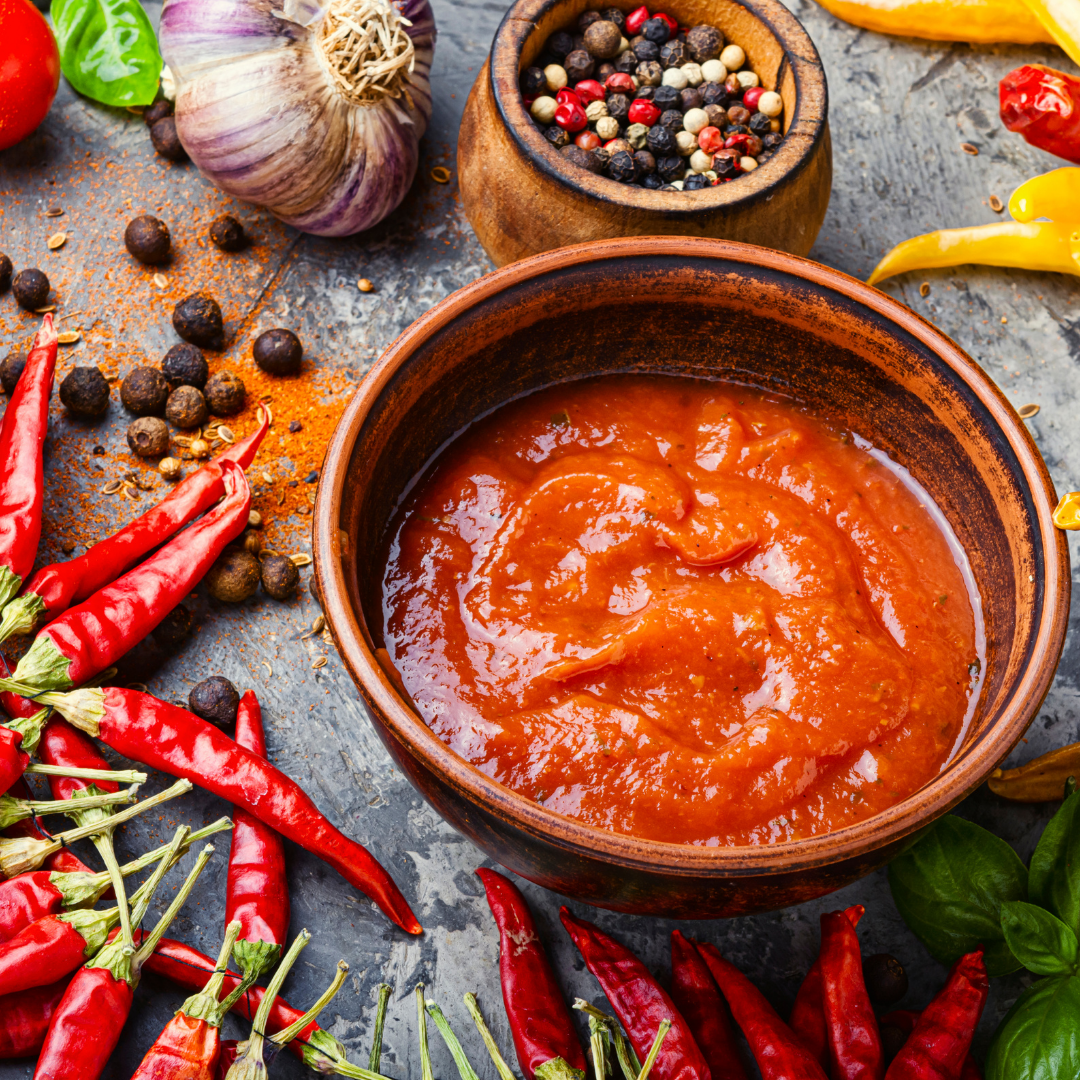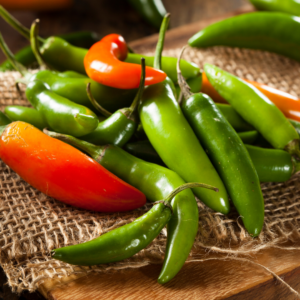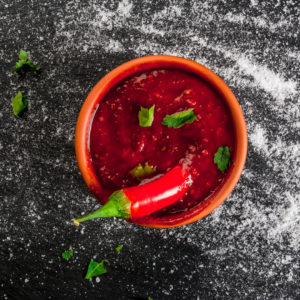Table of Contents
Fermentation of hot sauce is a simple process done at home. At Jar Kitchen, we’re huge fans of hot sauce, any and all kinds. In this post we cover everything you need to know to make your own fermented pepper hot sauce.
Adding a quarter onion or substituting bell peppers for a few jalapenos and serrano could help tone down the heat while maintaining the fermented taste. Naturally, other peppers can be used instead of jalapenos, although thin peppers may require the addition of another pepper to have enough sugars for microbial digestion.
Feel free to fiddle about with it, whatever you like.
- Flashbang Hot Sauce, An Explosion Heatwave!
- Lacto Fermented Hot Sauce, The Newest Sensation!
- Taco Bell Diablo Scoville, How Spicy Is It?
- What’s the Scoville Measure for Wasabi paste?
Making Fermented Hot Sauce? Follow These Steps
Step 1: Pick Your Style
To make your fermented pepper hot sauce, you’ll need to make many subtle decisions regarding what ingredients you use, how they’re prepared, and how they affect the final product. As a result, it’s a good idea to have a general notion of what kind of hot sauce you want to make before you get started. Consider the following broad categories:
- Louisiana-Style Fermented Sauces
- Mexican-Style Sauces
- Thick Commercial-Style Sauces
- Fermented Serrano Hot Sauce
- Other Styles: To cap it all off, you have access to an almost infinite variety of sauces that aren’t necessarily associated with a particular brand or category. Hot pepper mashes and pastes, such as gochujang, yuzu kosho, and doubanjiang, are examples of broken hot sauces that might be chunky or not emulsified.
Step 2: You should select from a variety of Chili Peppers.
As far as flavor and texture are concerned, your choice of peppers will have a significant impact.
Consider Fermented Serrano Hot Sauce
Serrano peppers in our opinion make a great fermented hot sauce. Their unique flavor, amazing texture and the taste sensation afforded by the fermentation process make it a GREAT condiment.
No matter which way you go, the more deliberate approach is preferable on occasion.
Fermented Habanero Hot Sauce Recipe
If you’re looking for a fermented habanero hot sauce recipe, check out our popular post on Fermented Habanero Hot Sauce.
Fresh Peppers Versus Dry Peppers for Fermented Hot Sauce
To begin, select fresh peppers with the most significant microbial potential. Find peppers that haven’t been treated with pesticides, waxed, or irradiated, all of which inhibit the growth of lactic acid bacteria.
Regardless of the type of peppers you choose, the most important thing is to taste them. Tasting helps you assess various factors and hints about the sauce’s future processing. Fresh peppers come in multiple flavors, textures, and heat levels. Listed below are a few elementary, yet crucial, considerations:
Spice Level of Fermented Pepper Hot Sauce
The heat of a chili pepper is one of the first things you need to know. Cayenne and Thai bird chilies are among the spiciest. Making a sauce comprised of hotter peppers like the Carolina Reaper will certainly be intolerable unless you’re a masochist. Cooking with hot peppers isn’t for the faint-hearted. Choosing a lesser chili pepper will give you a hot sauce with a more pure chile pepper flavor.
Thick or Thin Skin
The skin’s thickness is the primary concern you’ll notice about a chili pepper when you open it. Chilies like habanero, Fresno, and jalapeo are easy to chew because of their thin walls. It can be challenging to mix the hard outer peel of some peppers, such as cayenne or Anaheim chilies, and the result will be an unpleasant final texture. Smoother sauces made with thin-skinned peppers require less blending, and chunkier, broken-style hot sauces also benefit from their use. It’s possible to achieve a similar texture by peeling, straining, or pulverizing thick-skinned peppers.
Thick or Thin Wall
The pepper wall is the percentage of meat to membrane and seeds. Jalapeno chilies have thick walls and a lot of water. Without adding liquid, thick-walled peppers tend to be juicy and watery when chopped or blended.
Seeds and Membrane
Chili peppers bear either seeds or pithy white membranes, depending on the kind. On the other hand, the sources do not contribute to the pepper’s smoky flavor. However, Chile seeds can be unpleasant and abrasive when used in enormous amounts. White pithy peppers can make a sauce bitter. Remove the seeds and pith from the fruit before fermentation to eliminate the bitterness. If this is not the case, you can remove part of the seedy grain by draining the sauce after being prepared.
Actual Flavor of Fermented Hot Sauce Peppers
It’s important to distinguish the pepper’s genuine flavor from its spiciness, which brings us bitterness. Unripe peppers have a more harsh and grassy flavor than ripe peppers. Ripe peppers that are orange, red, or yellow tend to taste sweeter and more fruity than green or brown. Most people assume that chile peppers are all heat, but chile peppers can have a distinct flavor and aroma like any other fruit.
Step 3: Get them Ready
You’ve picked your peppers, whether it’s just one variety or a mix of many. Preparation and processing follow. Peppers should be rinsed and dried at the very least to remove any wax or dirt that may have remained on them. Removing woody stems is the next step, as they have a terrible taste and feel (at best, they’re bitter). Peel and de-seed the peppers with a vegetable peeler or paring knife if they are unusually thick-skinned or seedy.
Step 4: It’s time to look at a few backup players
In making fermented hot sauce, additional ingredients are added during the first stage of fermentation. You can include vegetables and aromatics such as carrots, beets, garlic, and onions, and sweet fruits like berries. In many cases, these additives are used to counterbalance the sauce’s heat and flavor.
Step 5: Pack and Ferment
Using a food-safe plastic or glass container with a tight-fitting lid is ideal. Wide containers are often less feasible because of the higher surface area exposed to the air at the top.
Simply dumping the salt brine into the vessel completes the process. It’s best to avoid air pockets by compressing the mash thoroughly inside the jar. Less oxygen at the beginning of fermentation means better and more efficient fermentation. Make sure there’s room for your head in the pot too. During fermentation, the mash rises to the top of the container.
Read more about the Lacto Fermentation Process
Step 6: Monitor and Wait
You’ve got it all worked out. An airlock has been used to keep the contents of your jar secure. Only wait for the microorganisms to do their job, and you’ll be done. However, how can you ensure that your fermentation is a success? Some things to keep an eye out for are:
Temperature
There’s a lot written about the “optimal” fermentation temperature. In reality, most individuals prefer the temperature of their kitchen countertop.
When Will the Fermented Pepper Hot Sauce Be Ready?
Fermentation takes 7-14 days on average to complete. It happens faster at higher temperatures. Finally, there are two dependable ways to assess if the ferment is edible. First, use pH strips or a pH meter to check pH. According to the FDA, an acidified food’s natural pH should be 4.6 or lower. A pH of 4.2 or lower is considered safe by most commercial hot sauce makers. Experts say a pH 3.4 or lower is the preferred pH for shelf-stable homemade sauces.
You can also taste your ferment for acidity. Every day for a week, open the jar and try a little bit of everything. “As long as it’s acidic,” Shockey says. “My palette has never erred. Sourness and acidity are common outcomes of fermentations. No need to worry about it.”
Step 7: Post-Fermentation Processing
You’re almost there. Step-by-step instructions have been followed, and the pH of your peppers has been maintained at or below 4.0. Surely we can throw everything in the blender and be done with it? There’s more to it than meets the eye.
Before blending, it’s a good idea to remove some or all of the brine from the peppers you’ve fermented. To avoid this, you may end up with a watery or thin hot sauce that lacks flavor. All that is needed to make a basic hot sauce is a small amount of brine mixed with fermented peppers (and anything else you might have added to the mix at the beginning). Depending on the amount of brine and the degree of blending, these sauces can have a range of textures, from coarse and runny to smooth and thick.
Step 8: Flavors to Add to Fermented Pepper Hot Sauce
Seasonings and consistency-adjustment additives are the two most common types of additives. When added to the mix, these additives are intended to enhance flavor or texture.
Seasoning
Salt is a natural seasoning. Adding salt to a hot sauce often brings out the underlying tastes, especially when fermenting at low salt concentrations.
Vinegar is another possibility. Its acetic acid content, which is harsher and more intense than lactic acid, gives it a more substantial, more intense acidity. While LAB fermentation adds funk and depth, a little bottled vinegar can enhance the natural edge. Finally, adding vinegar lowers the sauce’s pH (to 3.4), improving shelf stability.
Seasonings such as soy sauce, miso, or fish sauce are more upscale options. Salt and a spicy complexity are added to the sauce using these components; they can also be highly potent, so take caution.
Step 9: Storage of Fermented Pepper Hot Sauce
Refrigeration is the most excellent way to keep your sauce fresh. Heat treating the sauce (which kills any potential fermenting bacteria) before bottling and capping it with an airtight seal (albeit heat can modify the sauce’s flavor) is an option. You can also use preservatives like potassium sorbate and sulfite to destroy bacteria.
Other Types of Fermented P

This is Berk from the JarKitchen Team. I am a Mechatronics Engineer and I like cooking in my spare time. By bringing my engineering background into the business, product reviews are a specialty for me. During my travels across Europe, I have learned/tested many recipes and now I plan to bring them to you here!








